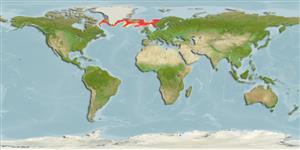Ελασμοβράγχιοι (καρχαρίες και σαλάχια) (sharks and rays) >
Rajiformes (Skates and rays) >
Rajidae (Skates)
Etymology: Rajella: Latin, raja, -ae = a sting ray (Raja sp.) (Ref. 45335).
Environment: milieu / climate zone / depth range / distribution range
Οικολογία
Θαλασσινό(ά) βαθύβιο(ς); εύρος βάθους 150 - 2117 m (Ref. 5951), usually 250 - ? m (Ref. 117245). Deep-water; 4°C - 6°C (Ref. 117245); 78°N - 42°N, 70°W - 30°E (Ref. 114953)
North Atlantic Ocean and adjacent fringes of the Arctic Region. Reported from the western Atlantic on eastern Grand Banks and Flemish Cap (about 46°N), a few records on the slope off Strait of Belle Isle to Davis Strait; probably continuous along the slope off Labrador; restricted in southwestern part of Greenland; eastern Atlantic off to most of Iceland to Faroe Islands, possible occurrence in western Irminger Sea and south to northern Rockall Trough; common in the Norwegian Deep and Skagerrak and northward along the Norwegian coast and shelf; periodic records in the southwestern Barents Sea.
Length at first maturity / Μέγεθος / Βάρος / Age
Maturity: Lm ?, range 97 - ? cm
Max length : 125 cm TL αρσενικό/απροσδιόριστο; (Ref. 119696); μεγ. δημοσιευμένο βάρος: 11.2 kg (Ref. 40637)
Short description
Μορφολογία | Μορφομετρία
Ραχιαίες άκανθες (συνολικά): 0; Εδρικές άκανθες 0; Μαλακές εδρικές ακτίνες: 0. Snout moderately long, its tip pointed and somewhat protruding; upper surface predominantly smooth, only on head and front margins more or less prickly, tail entirely spinulose, underside smooth; up to 4 thorns in front of as well as behind eye, a continuous median row of 42-51 thorns from nape to first dorsal fin (Ref. 3167). Upper surface plain fawn color, slate grey or clay grey, lower surface white, with a grey longitudinal band along tail and grey blotch on either side of cloaca (Ref. 6902).
Occur in moderately deep water but mainly around 250 m in boreal and partly arctic latitudes (Ref. 3167). Maximum reported depth at 2,117 m (Ref. 117245). Benthic (Ref. 58426). Feed on all kinds of bottom animals (Ref. 3167), invertebrates and fishes (Ref. 114953). Males mature at ca. 90 cm TL and young hatch at ca. 15 cm TL (Ref. 119696). Oviparous. Distinct pairing with embrace. Young may tend to follow large objects, such as their mother (Ref. 205). Eggs are oblong capsules with stiff pointed horns at the corners deposited in sandy or muddy flats (Ref. 205). Egg capsules are 10.7 cm long and 7.7 cm wide (Ref. 41251, 41301). It is not commercially important, and is possibly taken at low level by-catch in deep-water longline and trawl fisheries (Ref. 117245).
Life cycle and mating behavior
Γεννητική Ωρίμανση | Αναπαραγωγή | Γεννοβολία | Αβγά | Γονιμότητα | Προνύμφες
Oviparous (Ref. 3167). Paired eggs are laid. Embryos feed solely on yolk (Ref. 50449). Distinct pairing with embrace. Young may tend to follow large objects, such as their mother (Ref. 205).
McEachran, J.D. and K.A. Dunn, 1998. Phylogenetic analysis of skates, a morphologically conservative clade of elasmobranchs (Chondrichthyes: Rajidae). Copeia 1998(2):271-290. (Ref. 27314)
IUCN Red List Status (Ref. 130435)
Threat to humans
Harmless
Human uses
αλιεία αναψυχής: ναί
Περισσότερες πληροφορίες
ΑναφορέςΥδατοκαλλιέργειεςΠροφίλ υδατοκαλλιέργειαςΣτελέχοιΓενετικήElectrophoresesΚληρονομικότηταΑσθένειεςΜεταποίησηNutrientsMass conversion
Εργαλεία
Special reports
Download XML
Διαδικτυακές πηγές
Estimates based on models
Preferred temperature (Ref.
123201): 1 - 8, mean 5.2 °C (based on 216 cells).
Phylogenetic diversity index (Ref.
82804): PD
50 = 0.5000 [Uniqueness, from 0.5 = low to 2.0 = high].
Bayesian length-weight: a=0.00302 (0.00141 - 0.00645), b=3.24 (3.07 - 3.41), in cm total length, based on LWR estimates for this (Sub)family-body shape (Ref.
93245).
Τροφικό Επίπεδο (Ref.
69278): 3.8 ±0.45 se; based on food items.
Ελαστικότητα (Ref.
120179): Χαμηλό, ελάχιστος χρόνος για διπλασιασμό πληθυσμού 4,5 - 14 έτη (Fec assumed to be <100).
Fishing Vulnerability (Ref.
59153): High to very high vulnerability (75 of 100).
Climate Vulnerability (Ref.
125649): Moderate to high vulnerability (54 of 100).
Nutrients (Ref.
124155): Calcium = 3.33 [0.48, 63.71] mg/100g; Iron = 0.27 [0.03, 3.63] mg/100g; Protein = 15.3 [13.3, 17.4] %; Omega3 = 0.449 [0.186, 1.105] g/100g; Selenium = 21.2 [3.8, 98.1] μg/100g; VitaminA = 3.65 [0.27, 47.82] μg/100g; Zinc = 0.24 [0.02, 2.78] mg/100g (wet weight);
